pink-book
pink-book
pink-book
Create successful ePaper yourself
Turn your PDF publications into a flip-book with our unique Google optimized e-Paper software.
—Not experts. Exclude market<br />
researchers and advertising<br />
professionals (because of their<br />
familiarity with the methodology) and<br />
those who have, or might be perceived<br />
by other group members as having,<br />
expertise in the subject matter (e.g.,<br />
exclude health professionals from focus<br />
groups when the topic is a health issue).<br />
—Relative newcomers to focus groups or<br />
interviews, so that their reactions will be<br />
spontaneous. This will help you avoid<br />
“professional” respondents (i.e., those<br />
who have participated in many previous<br />
focus groups or individual interviews<br />
before) who may lead or monopolize<br />
the discussion.<br />
• The number of groups you will convene.<br />
—Divide participants into different focus<br />
groups based on their gender, race,<br />
age, level of formal education, or any<br />
other variable likely to hinder their<br />
freedom of expression (e.g., teenage<br />
girls will be more comfortable<br />
discussing sexual activity if teenage<br />
boys or college-age women are not in<br />
the group).<br />
—Conduct a minimum of two focus groups<br />
with each intended audience segment<br />
(e.g., if you are conducting separate<br />
groups with men and women, you will<br />
need at least four groups—two with<br />
men, two with women). If intended<br />
audience perceptions vary or the<br />
audience feedback is unclear, you may<br />
want to conduct additional groups with<br />
each segment, especially if you revise<br />
the discussion guide to more fully<br />
explore unresolved issues.<br />
—If you are using in-depth interviews,<br />
conduct approximately 10 interviews<br />
per intended audience segment. If<br />
common themes do not emerge or the<br />
intended audience feedback is unclear,<br />
you may want to conduct additional<br />
interviews, especially if you revise the<br />
interview guide in between interviews.<br />
Choose the Location<br />
You can convene focus group discussions or<br />
in-depth interviews in a variety of ways:<br />
• Commercial focus group facilities can<br />
recruit participants for you (for both focus<br />
groups and interviews) and offer audio<br />
and video recording equipment as well as<br />
observation rooms with one-way mirrors<br />
for viewing. However, these facilities are<br />
usually available only in larger<br />
metropolitan areas.<br />
• Teleconference services can set up<br />
telephone focus groups for you. Most allow<br />
observers to listen without being heard,<br />
and some provide remote viewing<br />
programs to allow the moderator to see a<br />
list of participant names (with a symbol<br />
next to the one currently speaking) or<br />
notes sent in by a technician from<br />
observers listening to the call. Some<br />
teleconference services can recruit<br />
participants; with others, you will have to<br />
recruit participants or contract with a<br />
recruiter separately.<br />
• You can also conduct focus groups or<br />
in-depth interviews in meeting rooms at<br />
churches, office buildings, or other<br />
locations. If an observation room with a<br />
one-way mirror is not available, staff may<br />
still listen in through speakers hooked up<br />
in a nearby room or by audiotaping or<br />
videotaping the session. In some cases,<br />
one or two quiet observers may be<br />
allowed in the room to take notes.<br />
See the sidebar Pros and Cons of Different<br />
Formats on the next page for the advantages<br />
and disadvantages of different formats for<br />
focus group and in-depth interview research.<br />
134 Communication Research Methods


